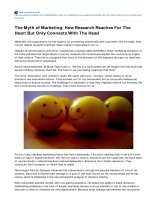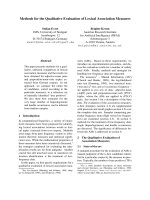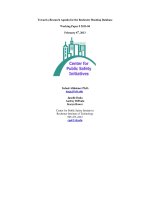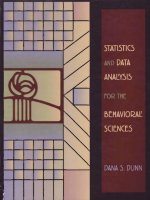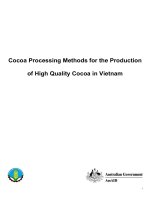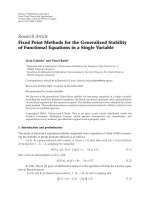Research methods for the behavioral charles stangor wadsworth
Bạn đang xem bản rút gọn của tài liệu. Xem và tải ngay bản đầy đủ của tài liệu tại đây (5.99 MB, 467 trang )
Stages in Conducting Research
Research is conducted in a series of stages. Each stage deals with a fundamental research issue, and each of
these issues relates to the presentation of the research in the formal research report. This table summarizes these
relationships.
Research Goals and Questions
Section of the
Research Report
Creating the research hypothesis
What is the research problem?
Why is the research important?
What are the goals of the research?
What is the relationship of this research to previous research?
What is the research hypothesis?
INTRODUCTION
Creating the research design
What research design should be used?
What manipulations and/or measures should be used?
What participants should be used?
What procedures should be used to collect the data?
METHOD
Analyzing the results
What statistical procedures should be used?
What is a fair and accurate description of the collected data?
How should the data be presented?
RESULTS
Interpreting the data
What is the meaning of the data?
What are the important conclusions of the research?
What are the limitations of the research?
What are the implications of the research for everyday life?
What suggestions can be made for further research?
DISCUSSION
RESEARCH METHODS
for the
Behavioral Sciences
FOURTH EDITION
Charles Stangor
University of Maryland
Australia • Brazil • Japan • Korea • Mexico • Singapore • Spain • United Kingdom • United States
Research Methods for the Behavioral
Sciences, Fourth Edition
Charles Stangor
Publisher/Executive Editor: Jon-David Hague
Developmental Editor: Trina Tom
Editorial Assistant: Alicia McLaughlin
Media Editor: Mary Noel
Marketing Manager: Jessica Egbert
Marketing Coordinator: Anna Andersen
Marketing Communications Manager:
Talis Wise
Content Project Management: Pre-Press
PMG
© 2011, 2007 Wadsworth, Cengage Learning
ALL RIGHTS RESERVED. No part of this work covered by the copyright
herein may be reproduced, transmitted, stored, or used in any form or by
any means graphic, electronic, or mechanical, including but not limited to
photocopying, recording, scanning, digitizing, taping, Web distribution,
information networks, or information storage and retrieval systems, except
as permitted under Section 107 or 108 of the 1976 United States Copyright
Act, without the prior written permission of the publisher.
For product information and technology assistance, contact us at
Cengage Learning Customer & Sales Support, 1-800-354-9706
For permission to use material from this text or product,
submit all requests online at cengage.com/permissions
Further permissions questions can be emailed to
Creative Director: Rob Hugel
Art Director: Vernon Boes
Library of Congress Control Number: 2009942928
Print Buyer: Judy Inouye
ISBN-13: 978-0-8400-3197-6
Rights Acquisitions Account Manager, Text:
Bob Kauser
ISBN-10: 0-8400-3197-1
Rights Acquisitions Account Manager, Image:
Robyn Young
Wadsworth
20 Davis Drive
Belmont, CA 94002-3098
USA
Production Service: Pre-Press PMG
Copy Editor: Pre-Press PMG
Cover Designer: Irene Morris
Cover Image: © Veer
Compositor: Pre-Press PMG
Cengage Learning is a leading provider of customized learning solutions
with office locations around the globe, including Singapore, the United
Kingdom, Australia, Mexico, Brazil, and Japan. Locate your local office at
www.cengage.com/global
Cengage Learning products are represented in Canada by
Nelson Education, Ltd.
To learn more about Wadsworth, visit www.cengage.com/Wadsworth
Purchase any of our products at your local college store or at our preferred
online store www.CengageBrain.com
Printed in the United States of America
1 2 3 4 5 6 7 14 13 12 11 10
Brief Contents
Preface
PART ONE
xv
GETTING STARTED
1
1
2
3
Introduction to Research
2
Developing the Research Hypothesis
Ethics in Research
41
PART TWO
MEASURING AND DESCRIBING
4
5
6
7
PART THREE
8
9
10
PART FOUR
11
12
13
14
APPENDIX A
APPENDIX B
APPENDIX C
APPENDIX D
APPENDIX E
APPENDIX F
Measures
66
Reliability and Validity
Surveys and Sampling
Naturalistic Methods
25
65
88
106
127
TESTING RESEARCH HYPOTHESES
Hypothesis Testing and Inferential Statistics
Correlational Research Designs
159
Experimental Research: One-Way Designs
141
142
183
DESIGNING AND INTERPRETING RESEARCH
205
Experimental Research: Factorial Designs
206
Experimental Control and Internal Validity
227
External Validity
254
Quasi-Experimental Research Designs
272
Reporting Research Results
290
Data Preparation and Univariate Statistics
Bivariate Statistics
358
Multivariate Statistics
374
Statistical Tables
395
Using Computers to Collect Data
415
Glossary
418
References
429
Index
436
338
iii
Contents
Preface
xv
PART ONE
GETTING STARTED
1
1
Introduction to Research
2
Behavioral Research
4
Everyday Science Versus Empirical Research
Relying on Our Intuition
6
Discovering the Limitations of Using Intuition
5
6
The Scientific Method
8
Values Versus Facts in Scientific Research
8
Basic and Applied Research
11
The Importance of Studying Research Methods
Evaluating Research Reports
12
Conducting Research
12
Thinking Critically About Research
12
13
Research Designs: Three Approaches to Studying Behavior
13
Descriptive Research: Assessing the Current State of Affairs
14
Correlational Research: Seeking Relationships Among Variables
16
Experimental Research: Understanding the Causes of Behavior
18
The Selection of an Appropriate Method
19
Current Research in the Behavioral Sciences: Preferences for Brands
That Contain the Letters of Our Own Name
20
SUMMARY
21
KEY TERMS
22
REVIEW AND DISCUSSION QUESTIONS
RESEARCH PROJECT IDEAS
23
2
Developing the Research Hypothesis
Getting Ideas
26
Solving Important Real-World Problems
Using Observation and Intuition
27
Using Existing Research
28
iv
23
27
25
v
CONTENTS
Doing a Literature Search
30
Locating Sources of Information
Conducting the Search
31
30
Formalizing Ideas Into Research Hypotheses
Laws
35
Theories
35
The Research Hypothesis
37
SUMMARY
38
KEY TERMS
39
REVIEW AND DISCUSSION QUESTIONS
RESEARCH PROJECT IDEAS
39
3
35
39
Ethics in Research
41
What Is Ethical Research?
42
Protecting Research Participants From Physical
and Psychological Harm
44
Types of Threats
44
The Potential for Lasting Impact
Providing Freedom of Choice
46
47
Conducting Research Outside the Laboratory
47
Securing Informed Consent
48
Weighing Informed Consent Versus the Research Goals
Maintaining Awareness of Power Differentials
50
51
Avoiding Abuses of Power
51
Respecting Participants’ Privacy
51
Honestly Describing the Nature and Use of the Research
When Deception Is Necessary
53
Simulation Studies: An Alternative to Deception
The Consequences of Deception
54
Debriefing
54
Using Animals as Research Participants
Ensuring That Research Is Ethical
57
53
56
The Institutional Review Board
59
The Researcher’s Own Ethics
60
Correctly and Honestly Reporting Research Results
SUMMARY
61
KEY TERMS
61
REVIEW AND DISCUSSION QUESTIONS
62
RESEARCH PROJECT IDEAS
62
60
52
vi
CONTENTS
PART TWO
MEASURING AND DESCRIBING
4
65
Measures
66
Fundamentals of Measurement
Operational Definition
67
67
Converging Operations
68
Conceptual and Measured Variables
Nominal and Quantitative Variables
Measurement Scales
71
Self-Report Measures
69
70
72
Free-Format Self-Report Measures
72
Fixed-Format Self-Report Measures
74
Reactivity as a Limitation in Self-Report Measures
Behavioral Measures
79
80
Nonreactive Measures
82
Psychophysiological Measures
82
Choosing a Measure
83
Current Research in the Behavioral Sciences:
Using Multiple Measured Variables to Assess the
Conceptual Variable of Panic Symptoms
84
SUMMARY
86
KEY TERMS
86
REVIEW AND DISCUSSION QUESTIONS
RESEARCH PROJECT IDEAS
87
5
87
Reliability and Validity
Random and Systematic Error
Reliability
91
88
89
Test-Retest Reliability
91
Reliability as Internal Consistency
Interrater Reliability
95
Construct Validity
92
95
Face Validity
96
Content Validity
97
Convergent and Discriminant Validity
Criterion Validity
99
97
Improving the Reliability and Validity of Measured Variables
100
Comparing Reliability and Validity
101
Current Research in the Behavioral Sciences: The Hillyer-Joynes
Kinematics Scale of Locomotion in Rats With Spinal Injuries
103
vii
CONTENTS
SUMMARY
104
KEY TERMS
104
REVIEW AND DISCUSSION QUESTIONS
RESEARCH PROJECT IDEAS
105
6
105
Surveys and Sampling
Surveys
106
107
Interviews
107
Questionnaires
108
Use of Existing Survey Data
109
Sampling and Generalization
110
Definition of the Population
110
Probability Sampling
110
Sampling Bias and Nonprobability Sampling
Summarizing the Sample Data
112
114
Frequency Distributions
114
Descriptive Statistics
118
Sample Size and the Margin of Error
122
Current Research in the Behavioral Sciences:
Assessing Americans’ Attitudes Toward Health Care
SUMMARY
124
KEY TERMS
124
REVIEW AND DISCUSSION QUESTIONS
RESEARCH PROJECT IDEAS
126
7
123
125
Naturalistic Methods
127
Naturalistic Research
128
Observational Research
129
The Unacknowledged Participant
130
The Acknowledged Participant
131
Acknowledged and Unacknowledged Observers
Case Studies
132
Systematic Coding Methods
132
133
Deciding What to Observe
134
Deciding How to Record Observations
Choosing Sampling Strategies
135
134
Archival Research
135
Current Research in the Behavioral Sciences:
Detecting Psychopathy From Thin Slices of Behavior
SUMMARY
KEY TERMS
138
139
137
viii
CONTENTS
REVIEW AND DISCUSSION QUESTIONS
RESEARCH PROJECT IDEAS
139
139
PART THREE
TESTING RESEARCH HYPOTHESES
8
141
Hypothesis Testing and Inferential Statistics
Probability and Inferential Statistics
143
Sampling Distributions and Hypothesis Testing
The Null Hypothesis
146
Testing for Statistical Significance
Reduction of Inferential Errors
142
145
147
149
Type 1 Errors
149
Type 2 Errors
150
Statistical Power
151
The Tradeoff Between Type 1 and Type 2 Errors
Statistical Significance and the Effect Size
152
153
Practical Uses of the Effect-Size Statistic
154
SUMMARY
156
KEY TERMS
156
REVIEW AND DISCUSSION QUESTIONS
157
RESEARCH PROJECT IDEAS
157
9
Correlational Research Designs
159
Associations Among Quantitative Variables
160
Linear Relationships
162
Nonlinear Relationships
162
Statistical Assessment of Relationships
The Pearson Correlation Coefficient
The Chi-Square Statistic
164
Multiple Regression
168
Correlation and Causality
163
163
170
Interpreting Correlations
170
Using Correlational Data to Test Causal Models
173
When Correlational Designs Are Appropriate
177
Current Research in the Behavioral Sciences: Moral Conviction,
Religiosity, and Trust in Authority
179
SUMMARY
180
KEY TERMS
180
REVIEW AND DISCUSSION QUESTIONS
RESEARCH PROJECT IDEAS
181
181
CONTENTS
10
Experimental Research: One-Way Designs
Demonstration of Causality
ix
183
184
Association
184
Temporal Priority
185
Control of Common-Causal Variables
185
One-Way Experimental Designs
185
The Experimental Manipulation
186
Selection of the Dependent Variable
187
Variety and Number of Levels
188
Analysis of Variance
190
Hypothesis Testing in Experimental Designs
190
Between-Groups and Within-Groups Variance Estimates
The ANOVA Summary Table
191
Repeated-Measures Designs
191
193
Advantages of Repeated-Measures Designs
194
Disadvantages of Repeated-Measures Designs
194
When to Use a Repeated-Measures Design
196
Presentation of Experiment Results
197
When Experiments Are Appropriate
198
Current Research in the Behavioral Sciences:
Does Social Exclusion “Hurt”?
199
SUMMARY
200
KEY TERMS
201
REVIEW AND DISCUSSION QUESTIONS
RESEARCH PROJECT IDEAS
202
201
PART FOUR
DESIGNING AND INTERPRETING RESEARCH
11
205
Experimental Research: Factorial Designs
Factorial Experimental Designs
206
207
The Two-Way Design
208
Main Effects
209
Interactions and Simple Effects
211
The ANOVA Summary Table
211
Understanding Interactions
213
Patterns of Observed Means
213
Interpretation of Main Effects When Interactions Are Present
More Factorial Designs
216
The Three-Way Design
216
Factorial Designs Using Repeated Measures
218
215
x
CONTENTS
Comparison of the Condition Means in Experimental Designs
Pairwise Comparisons
Complex Comparisons
Current Research in the Behavioral Sciences:
Using Feelings in the Ultimatum Game
SUMMARY
224
KEY TERMS
224
REVIEW AND DISCUSSION QUESTIONS
RESEARCH PROJECT IDEAS
225
12
219
219
221
222
225
Experimental Control and Internal Validity
Threats to the Validity of Research
Experimental Control
229
228
Extraneous Variables
230
Confounding Variables
230
Control of Extraneous Variables
231
Limited-Population Designs
232
Before-After Designs
232
Matched-Group Designs
234
Standardization of Conditions
235
Creation of Valid Manipulations
236
Impact and Experimental Realism
236
Manipulation Checks
237
Confound Checks
239
How to Turn Confounding Variables Into Factors
Pilot Testing
240
Threats to Internal Validity
240
241
Placebo Effects
242
Demand Characteristics
243
Experimenter Bias
245
Random Assignment Artifacts
247
Current Research in the Behavioral Sciences:
Testing the “Romantic Red” Hypothesis
SUMMARY
249
KEY TERMS
250
REVIEW AND DISCUSSION QUESTIONS
RESEARCH PROJECT IDEAS
251
250
248
227
CONTENTS
13
External Validity
xi
254
Understanding External Validity
Generalization
256
255
Generalization Across Participants
256
Generalization Across Settings
258
Replications
260
Exact Replications
260
Conceptual Replications
260
Constructive Replications
261
Participant Replications
262
Summarizing and Integrating Research Results
Research Programs
264
Review Papers
264
Meta-Analysis
264
Interpretation of Research Literatures
263
267
Current Research in the Behavioral Sciences: A Meta-Analysis of the
Effectiveness of Current Treatment Approaches for Withdrawal
From Tranquilizer Addictions
268
SUMMARY
269
KEY TERMS
269
REVIEW AND DISCUSSION QUESTIONS
RESEARCH PROJECT IDEAS
270
14
270
Quasi-Experimental Research Designs
Program Evaluation Research
Quasi-Experimental Designs
273
274
Single-Group Design
274
Comparison-Group Design
276
Single-Group Before-After Design
277
Comparison-Group Before-After Design
278
Regression to the Mean as a Threat to Internal Validity
Time-Series Designs
281
Participant-Variable Designs
272
279
283
Demographic Variables
283
Personality Variables
284
Interpretational Difficulties
284
Single-Participant Designs
284
Current Research in the Behavioral Sciences: Damage to the
Hippocampus Abolishes the Cortisol Response to Psychosocial
Stress in Humans
286
xii
CONTENTS
SUMMARY
287
KEY TERMS
288
REVIEW AND DISCUSSION QUESTIONS
RESEARCH PROJECT IDEAS
289
APPENDIX A
288
Reporting Research Results
290
Communication of Scientific Knowledge
Face-to-Face Contact
291
Publication in Scientific Journals
The Research Report
291
292
295
Headings in APA Format
296
Title Page
297
Abstract
299
Introduction
301
Method
303
Results
304
Discussion
306
References
307
Footnotes and Author Notes
309
Tables and Figures
309
Tips on Writing the Research Report
SUMMARY
311
KEY TERMS
311
REVIEW AND DISCUSSION QUESTIONS
RESEARCH PROJECT IDEAS
312
APPENDIX B
310
312
Data Preparation and Univariate Statistics
Preparing Data for Analysis
338
339
Collecting the Data
339
Analyzing the Data
340
Entering the Data Into the Computer
340
Checking and Cleaning the Data
342
Dealing with Missing Data
343
Deleting and Retaining Data
344
Transforming the Data
346
Conducting Statistical Analysis
346
Descriptive Statistics, Parameters, and Inferential Statistics
Statistical Notation
347
Computing Descriptive Statistics
Frequency Distributions
348
Measures of Central Tendency
348
349
346
CONTENTS
Measures of Dispersion
350
Computer Output
351
Standard Scores
352
The Standard Normal Distribution
352
Working With Inferential Statistics
354
Unbiased Estimators
354
The Central Limit Theorem
354
The Standard Error
354
Confidence Intervals
355
SUMMARY
355
KEY TERMS
356
REVIEW AND DISCUSSION QUESTIONS
RESEARCH PROJECT IDEAS
357
APPENDIX C
356
Bivariate Statistics
358
The Pearson Correlation Coefficient
Calculating r
359
Obtaining the p-Value
Contingency Tables
359
361
362
The Chi-Square Test for Independence
Kappa
364
Bivariate Regression
362
366
The Regression Equation
366
The Regression Line
366
Partitioning of the Sum of Squares
One-Way Analysis of Variance
367
368
Computation of a One-Way Between-Participants ANOVA
The ANOVA Summary Table
371
Eta
372
SUMMARY
372
KEY TERMS
372
REVIEW AND DISCUSSION QUESTIONS
373
RESEARCH PROJECT IDEAS
373
APPENDIX D
Multivariate Statistics
Multiple Regression
375
Regression Coefficients
376
The Multiple Correlation Coefficient (R)
378
Hierarchical and Stepwise Analyses
378
Multiple Regression and ANOVA
379
Loglinear Analysis
xiii
379
369
374
xiv
CONTENTS
Means Comparisons
380
A Priori Contrast Analysis
380
Post Hoc Means Comparisons
382
Multivariate Statistics
383
Coefficient Alpha
383
Exploratory Factor Analysis
384
Canonical Correlation and MANOVA
Structural Equation Analysis
388
387
How to Choose the Appropriate Statistical Test
SUMMARY
392
KEY TERMS
393
REVIEW AND DISCUSSION QUESTIONS
RESEARCH PROJECT IDEAS
394
APPENDIX E
391
393
Statistical Tables
Statistical Table A: Random Numbers
395
396
Selecting a Random Sample
396
Selecting Orders for Random Assignment Conditions
396
Statistical Table B: Distribution of z in the Standard Normal
Distribution
398
Statistical Table C: Critical Values of t
402
Statistical Table D: Critical Values of r
403
Statistical Table E: Critical Values of Chi Square
405
Statistical Table F: Critical Values of F
406
Statistical Table G: Statistical Power
414
APPENDIX F
Using Computers to Collect Data
415
Glossary
418
References
429
Index
436
Preface
Research Methods for the Behavioral Sciences grew out of my perceived need
for a textbook that covers a complete body of research approaches, is accessible for a first-year undergraduate methods or laboratory class, and yet is still
detailed enough to serve as a reference book for students as they progress to
higher-level courses. I think you will find this book to be easily understood
by sophomores, yet comprehensive enough to serve as a useful handbook
for students working as research assistants or writing theses. Indeed, I use the
textbook as a test for my graduate students—if they know everything in it, I
can trust that they will be able to fully and adequately analyze their data or be
able to realize what other information they might need to do so.
Furthermore, I wanted a book that is balanced in emphasis between conducting and consuming research. For the consumer of research, I have incorporated many sections and much pedagogy on how to draw inferences from
existing research (see for instance the Research Project Ideas in Chapters 11,
12, and 14). I have devoted two full chapters to the essential topics of internal and external validity and have endeavored to use these chapters to help
develop students’ critical thinking and interpretive skills. But I have also filled
the book with practical advice for students who are conducting their own
research, including:
•
•
“Goals of an ethical research project” in Chapter 3
“Guide to improving the reliability and validity of questionnaires” in
Chapter 5
•
Sections in Chapter 12 concerned with designing valid and powerful
experiments
Appendix A on writing research reports
The section on data preparation and analysis in Appendix B
Appendix F on using computers to collect data
•
•
•
A number of examples of IBM SPSS printouts have been placed in the
chapters, allowing students to see how the statistics look when they are initially computed.
I have placed as much emphasis on nonexperimental research methods
as I have on experimental ones, arguing that all three research approaches—
descriptive, correlational, and experimental—have unique strengths and
weaknesses (see Table 1.3). Although the focus is primarily on quantitative
research, I have also pointed out the appropriate use of qualitative research,
xv
xvi
PREFACE
such as fo cus groups and case studies. I have devoted two full chapters
(4 and 5) to the important concerns of creating measures and evaluating their
effectiveness. My guess is that many of the students in this course will some
day have to design a survey, and in order to do so they will have to know
how to write effective, reliable, and valid items. Issues of measurement are
frequently underdeveloped in research methods texts, and I have tried to correct this omission.
I believe that this book simultaneously serves the needs of even the most
demanding instructor and yet can be enjoyed by students. I have tried to
make it thorough, interesting, integrative, accessible, and to provide an effective pedagogy. From an instructor’s perspective, I think this book will help
students enjoy learning about research methods, understand them well, and
think critically and creatively about research. From a student’s perspective, the
book is brief and succinct, concepts are easy to grasp, and there are several
helpful examples. As one reviewer put it, “The book basically represents the
most important concepts—what a student might highlight in a longer book.”
Organization and Coverage
The book is divided into four sections. Part One covers the background of
research.
Chapter 1 emphasizes the importance of research to citizens in contemporary society and the potential implications of using (or failing to use) research
to make decisions. Chapter 2 explains how science is conducted—the scientific
method and the use of the literature review to develop and refine the research
hypothesis. Chapter 3 represents a broad overview of research ethics, including practical guides for conducting ethical research.
Part Two deals with measures and measurement. Chapter 4 teaches students how to develop both self-report and behavioral measures and reviews
the strengths and weaknesses of each. Practical hints for constructing useful
measures are given. Chapter 5 covers the important aspects of reliability and
construct validity, and in more detail than any competing text. Chapter 6 presents the elements of surveys and sampling, and Chapter 7 introduces observational and archival methods. I have attempted to point out to students (and
instructors might note this as well) that the methods covered in these chapters
are both research designs (descriptive research), but also methods that can be
used as measured variables in correlational and experimental research.
The chapters in Part Three present the basics of testing research hypotheses. Chapter 8 covers the principles of hypothesis testing and inferential statistics, while Chapters 9 and 10 cover the logic of correlational and experimental
research, respectively. Chapter 9 includes sections on multiple regression, longitudinal designs, path analysis, and structural equation modeling.
Part Four considers the design and interpretation of complex experiments, including factorial experimental designs and means comparison tests
(Chapter 11). Internal and external validity are covered in Chapters 12 and 13,
PREFACE
xvii
respectively, and the Hands-On Experiences in these chapters provide a wealth
of examples. Chapter 12 also gives practical advice for designing effective
experiments. Chapter 14 reviews the strengths and difficulties of quasiexperimental research designs, with a focus on the many threats to internal
validity that they contain and how these threats can be overcome.
The Appendices are designed to supplement the text. They can be assigned
at any time during the course or used for reference afterward. Appendix A
presents an overview of how scientists share their data with others, including
a detailed description of how to write a research report following APA style.
This appendix also includes an annotated example of a research report written in APA format. Appendices B and C provide the formulas for most of the
univariate statistical tests contained in an introductory statistics text. Appendix
B also includes practical advice for analyzing data using computer software
programs, along with many examples of IBM SPSS outputs. Students who are
collecting and analyzing their own data should therefore find Appendix B
extremely useful in helping them understand how to interpret their results.
Appendix D summarizes the most commonly used multivariate research techniques, along with sample computer output. Although it is not likely that a
first-year methods student will need to conduct a factor or structural equation
analysis, these techniques are so common in contemporary research reports
that students should have a place to go to learn the basics of such techniques,
and accomplished students (for instance, those writing theses) should be able
to learn how to conduct them if necessary.
Statistical Issues
I assume that most students who are taking a research methods or laboratory
course are familiar with univariate statistical procedures, but I have designed
this book to function effectively even for courses in which the students are
not familiar with statistics. Although I cover many statistical issues in the book
itself (Chapter 6, “Surveys and Sampling”; Chapter 8, “Hypothesis Testing and
Inferential Statistics”; Chapter 9, “Correlational Research Designs”; and Chapters 10 and 11 on ANOVA), students who need a refresher can be directed
to Appendices B and C at any point in the semester. The text always references the Appendices that cover the calculations of the statistics under discussion. The placement of all calculations in the Appendices allows instructors to
choose whether and when to assign this material. Because of the increasing
importance of students’ learning to use computers to conduct statistical analyses, Appendix B introduces this process, and Appendix F, “Using Computers to Collect Data,” expands upon this topic. Many examples of computer
output are presented in the text and in the Appendices. The discussion is
framed around the Statistical Package for the Social Sciences—in my opinion the package with the most user-friendly platform. I also recommend the
accompanying manual, Using IBM SPSS for Windows, described on page xx,
for students who are going to be calculating statistics.
xviii
PREFACE
Pedagogical Features
To promote mastery of the broad array of concepts, terms, and applications
central to the research methods course, each chapter of the book includes
both standard pedagogical elements and several unique features:
•
•
•
•
•
•
•
A chapter outline provides a basic orientation to the chapter.
Unique chapter-opening Study Questions help students learn to
formulate appropriate questions about the topics that are to come before
reading the chapter. Students can review these questions again when
preparing for exams.
A new feature, Current Research in the Behavioral Sciences provides
students with examples of recent research studies. These studies can be
used as discussion points to help students learn about current trends in
behavioral research, and may also be used as background readings for
students who are looking for project ideas.
Boldface Key Terms and an end-of-text Glossary are useful tools for
learning and reviewing the vocabulary of the course.
A chapter Summary highlights the key points of the chapter.
Review and Discussion Questions help students assess their mastery
of chapter concepts and provide productive points of departure for
classroom discussion.
Particularly useful Research Project Ideas supply a wealth of practical
problems and exercises that complement and expand upon the examples
given in the text.
New to This Edition
In addition to a number of updates, the fourth edition of Research Methods for
the Behavioral Sciences has added a new feature, Current Research in the Behavioral Sciences, to provide students with examples of new research studies.
These studies can be used as discussion points to help students learn about
current trends in behavioral research, and may also be used as background
readings for students who are looking for project ideas.
Chapter 1:
New Feature: Current Research in the Behavioral Sciences: Preferences for
Brands That Contain the Letters of Our Own Name
Chapter 4:
New Feature: Current Research in the Behavioral Sciences: Using Multiple
Measured Variables to Assess the Conceptual Variable of Panic Symptoms
PREFACE
xix
Chapter 5:
New Feature: Current Research in the Behavioral Sciences: The Hillyer-Joynes
Kinematics Scale of Locomotion in Rats With Spinal Injuries
Chapter 6:
New Feature: Current Research in the Behavioral Sciences: Assessing Americans’ Attitudes Toward Health Care
Chapter 7:
New Feature: Current Research in the Behavioral Sciences: Detecting Psychopathy From Thin Slices of Behavior
Chapter 9:
New Feature: Current Research in the Behavioral Sciences: Moral Conviction,
Religiosity, and Trust in Authority
Chapter 10:
New Feature: Current Research in the Behavioral Sciences: Does Social Exclusion “Hurt”?
Chapter 11:
New Feature: Current Research in the Behavioral Sciences: Using Feelings in
the Ultimatum Game
Chapter 13:
New Feature: Current Research in the Behavioral Sciences: A Meta-Analysis
of the Effectiveness of Current Treatment Approaches for Withdrawal From
Tranquilizer Addictions
Chapter 14:
New Feature: Current Research in the Behavioral Sciences: Damage to the
Hippocampus Abolishes the Cortisol Response to Psychosocial Stress in
Humans
Appendix A:
The sample research report and reference formats have been updated to conform to the “sixth edition” of the American Psychological Association Publication Guide.
xx
PREFACE
Supplements to the Text
The following supplementary materials are available with Research Methods
for the Behavioral Sciences. Contact your local Cengage Learning representative for more information.
For Instructors:
Instructor’s Manual With Test Bank. Full answers to the Review and Discus-
sion Questions and the Hands-On Experiences can be found in the instructor’s resource manual (which is author-written). For the fourth edition, this
resource has been revised to include Learning Objectives at the beginning
of each chapter, and a research paper checklist that can be distributed as an
in-class handout.
Companion Website. Instructors will find content for each chapter including
glossary, flash cards, multiple-choice quizzing, and more. www.cengage.com/
psychology/stangor
For Students:
Using IBM SPSS® for Windows®, Fourth Edition. I have also written a manual
called Using IBM SPSS® for Windows® that introduces students to the basics of
IBM SPSS. This handbook, with step-by-step instructions, sample output, and
student exercises based on data sets provided on CD-ROM, can be shrinkwrapped with the text. The fourth edition has been fully updated to reflect
the current version of IBM SPSS software, including new screenshots, more
practice exercises, and additional data sets.
IBM SPSS® for Windows®, Software.
The current student version of IBM
SPSS software can be shrink-wrapped with the text and is available for sale to
students whose schools don’t license SPSS.
Companion Website. Students will find content for each chapter including
glossary, flash cards, multiple-choice quizzing, and more. www.cengage.com/
psychology/stangor
Acknowledgments
It is not possible for me to acknowledge all of the people who helped me
write this book. The list would include my students, whose questions, comments, and complaints taught me how to better teach research methods, convinced me of the need for this book, and helped me make the book more
useful. My wife, Leslie, supported me as only she can during and after the
long hours in front of the word processor. I am grateful to those who gave me
PREFACE
xxi
feedback and materials, including Lisa Aspinwall, Jude Cassidy, Jack Fyock,
Paul Hanges, Madeline Heilman, Bill Hodos, John Jost, Dave Kenny, James
Lange, and Gretchen Sechrist. I am particularly indebted to Jud Mills, who
read just about every word at least once and who was my own best instructor
in research methods. Thanks also to the Department of Psychology at the University of Maryland, to the members of the Society for Personality and Social
Psychology, and to the editorial and production group at Cengage Learning,
including Executive Editor Jon-David Hague, and Assistant Editor Trina Tom.
I would also like to acknowledge the helpful comments of the revision
reviewers. They helped shape the book and make it even more user-friendly:
•
•
•
•
•
•
•
•
•
•
•
•
•
•
•
•
•
•
Jay C. Brown, Texas Wesleyan University
Amy Dombach Connelly, Felician College
Julie Evey, University of Southern Indiana
Ronald S. Friedman, University at Albany, SUNY
Gary G. Ford, Stephen F. Austin State University
Deana L. Julka, University of Portland
Jennifer Trich Kremer, Penn State Erie, The Behrend College
Sean Laraway, San José State University
Don E. Lindley, Regis University
Marianne Lloyd, Seton Hall University
Donna Stuber-McEwen, Friends University
Ann V. McGillicuddy-De Lisi, Lafayette College
Terry F. Pettijohn, Ohio State University—Marion Campus
Pamela Schuetze, Buffalo State College
Brian C. Smith, Graceland University
Laurie Sykes Tottenham, University of Regina
Mary Moore Vandendorpe, Lewis University
Rose Marie Ward, Miami University
I am always interested in receiving comments from instructors and
students. You can write me at the Department of Psychology, University of
Maryland, College Park, MD 20742 or contact me via e-mail: Stangor@psyc.
umd.edu. I hope you find this book useful and enjoyable.
This page intentionally left blank
PART ONE
Getting
Started

